CDC Environmental Health Nexus Newsletter
Healthy Environment, Healthy You
Environmental health affects everyone. Each issue of this free newsletter provides information about environmental health that is current, relevant, and actionable, and what CDC is doing to help. You will get information about upcoming webinars, environmental threats to health, and steps people can take to protect themselves and their families.
Sign up for the EH Nexus newsletter.
Looking for previous EH Nexus newsletters? Find the archive here.
May 26, 2021 | Volume 2

Take Actions to Protect Yourself and Your Loved Ones During this Year’s Hurricane Season
Hurricanes Harvey, Irma, and Maria created mass destruction in Texas, Florida, Puerto Rico, and the U.S. Virgin Islands in 2017. According to the National Hurricane Centerpdf icon, Harvey is the second most costly hurricane in U.S. history, accounting for inflation, behind only Katrina (2005). At least 68 people died in Texas from the direct effects of the storm. The death toll was devastating but would have been far worse if not for many people’s preparations.
We continue to see powerful hurricane seasons. The 2020 season was the most active on record; Louisiana suffered three direct hits from hurricanes Laura, Delta, and Zeta.
Hurricanes cause strong winds, flooding, heavy rain, and storm surges, all of which can be fatal. They can cause damage hundreds of miles from the shore. CDC’s Environmental Health Nexus (EH Nexus) wants everyone to be prepared before a hurricane. This newsletter edition offers guidance for what to do prior to the warning, during a hurricane, and after the storm has passed.
CDC Environmental Health Nexus Webinar: Hurricane Safety and Preparedness
Be prepared for the start of hurricane season. Join the Environmental Health Nexus Webinar on Hurricane Safety and Preparedness. Subject matter experts from CDC will discuss strategies on how to keep you and your community safe during hurricane season.
This special webinar will be broadcast on CDC’s Emergency Preparedness and Response Facebook page on June 2 at 1 pm ET.
Closed captioning will be available through Streamtext.
Visit the Environmental Health Nexus website for more details.
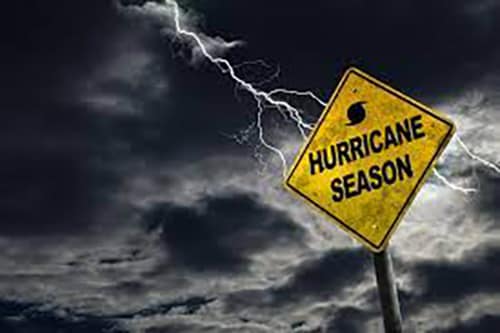
Prepare Now for a Hurricane
Hurricane season starts May 15 in the north Pacific, June 1 in the Atlantic and the Caribbean, and ends November 30. During and after a hurricane, you may need supplies to keep your family safe and healthy. Remember a hurricane can cut off your power and water supply. Also, you may not be able to drive because of damage to your car. Roads may be flooded or blocked. Make sure you and your family are prepared by planning ahead before hurricane season each year.
Be on Alert
Regardless of where hurricanes land, they can cause significant harm to life and damage property. Know where to go for evacuations and prepare to shelter. Listen for National Weather Service alerts on TV or radio or check online for information about shelters. If offered, sign up for text alerts by local weather or emergency service agencies. Have a plan for staying at home if evacuations are not issued, but also have a contingency plan if evacuating is recommended. Give yourself ample time to get out when the time comes and map your route ahead of time, plotting alternatives.
Develop an emergency action plan in case you become separated from your family and cannot reach them. When services and supplies are limited, it is important to have the personal needs, prescriptions, paperwork, power sources, and practical skills you need to respond. An emergency kit has all the things that you and your family may need during an emergency in which you may have to stay inside for longer than usual or if the electricity is out. You also can prepare a “go kit” in case you need to evacuate.
Some things to include may be:
- Extra batteries
- Bottled water (at least a gallon for each person and pet per day for 3 days) and nonperishable food
- First aid kit
- Flashlight
- Copies of important information
- Medications and other medical supplies
- Cash
- Disinfectant wipes and spray
- Bar or liquid soap
- Hand sanitizer with at least 60% alcohol
- Multiple, clean masks for everyone age 2 or older. Masks should have multiple layers and fit snugly against your face.
For additional hurricane planning information, please go here.
Prepare Your Home and Help Your Neighbors
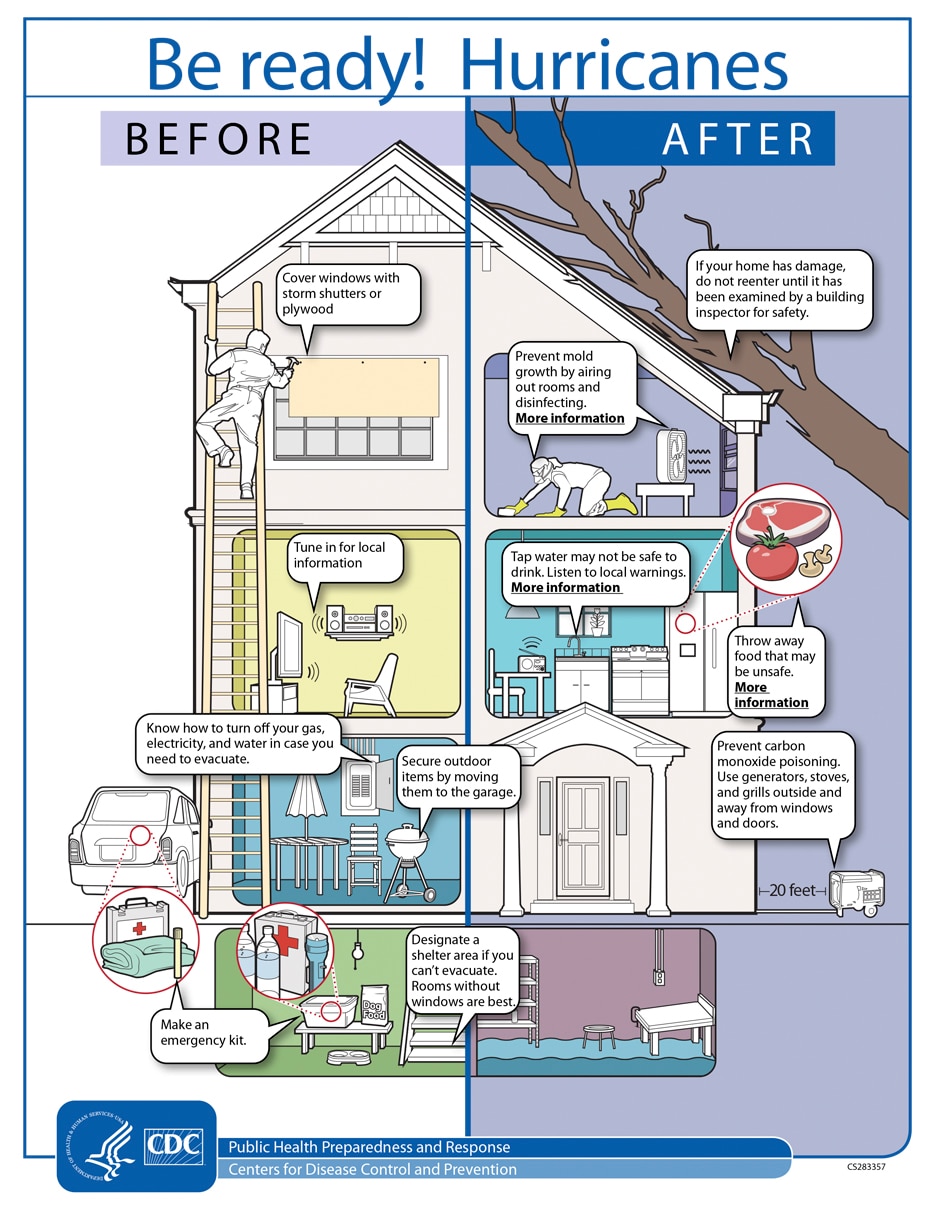
Be Ready! Hurricanes Infographic. Learn More
If a hurricane or severe flooding is coming, you may hear an order to evacuate (leave your home). Never ignore an order to evacuate.
Even sturdy, well-built houses may not hold up against an extreme storm with strong wind and high water. Staying home to protect your property is not worth risking your health and safety. It is important to know how to prepare and where you are vulnerable. Ask yourself the following questions:
- Am I in a flood-prone area?
- Do I live in a place that has limited access in and out?
- Will I have to navigate around potential hazards?
If you have friends, family, or other loved ones in hurricane-affected areas, you can help ensure they stay safe by sending them health and safety information.
CDC offers a toolkit with different messages in both English and Spanish you can send via text message, email, or social media. Post these messages on Twitter or Facebook and tag your friends and family in areas affected by hurricanes this year.
During A Hurricane

There will be a lot going on as the hurricane gets closer to your area, but always remain calm and follow directives from experts. Most people who experienced hurricanes describe them as vicious and say they cause havoc. For this, we emphasize preparedness and safety first.
Experts announce hurricane watches 48 hours before they expect tropical-storm-force winds—sustained winds of 39 to 73 mph— to start. A hurricane warning is even more serious. It means hurricane-force winds are expected in a stated area. Experts issue these warnings 36 hours before tropical-storm-force winds are expected in the area, to give people enough time to prepare for the storm.
If a watch is issued, make sure all possible steps in the previous section have been completed. Pack food and any necessary supplies for pets that may need to be evacuated as well. Do not leave pets at home when evacuating.
If evacuations are ordered, prepare a “go kit” with personal items you cannot do without during an emergency. Follow guidance from your local public health or emergency management officials on when and where to shelter. Remain calm and contact family members to let them know where the designated shelter is located. When a storm is only hours away and an evacuation was not ordered, stay at home.
Turn on the television to stay current with the storm’s progress. Local news and weather websites also provide updated information. Also, keep a portable battery-operated radio nearby. Charge all electronics. Close the storm shutters and go to a safe place away from doors or windows.
After A Hurricane
After an evacuation, do not return home until the area is deemed safe by local officials. Keep current with updates. Stay away from debris and bowed or fallen power lines. Do not walk or drive through moving flood waters. Also, damaged power sources may be hiding under the water to create a deadly risk.

The storm might be over, but that doesn’t mean the danger is. Keep your loved ones safe after the storm by following our safety tips:
- Stay out of flood water.
- Never use a wet electrical device.
- If the power is out, use flashlights instead of candles.
- Take care of your emotional health.
- Be careful near damaged buildings.
- Stay away from power lines.
- Protect yourself from animals and pests.
- Drink safe water. Eat safe food.
- Wash your hands.
- Take care of any wounds or injuries to prevent infection.
- Clean up your home safely: wear clothing and equipment that protects you.
- If you have a generator, keep it outdoors, at least 20 feet from any door, window, or vent, to prevent carbon monoxide (CO) poisoning. Use a battery-powered CO detector.
Taking care of your and your family’s emotional health is essential after a hurricane. The days and weeks after a hurricane are rough. In addition to your physical health, you need to take some time to consider your mental health as well. Remember that children need extra care and attention before, during, and after the storm. Your state and local health departments will help you find the local resources, including hospitals or health care providers, that you may need. Taking care of your emotional health during an emergency will help you think clearly and react to the urgent needs to protect yourself and your family during an emergency.
Additional Web And Multimedia Resources
Below are useful resources to educate and prepare yourself and your family:
- Be prepared for 2021 hurricane season. Learn more.
- Stay Safe After a Hurricane or Other Tropical Storm.
- Visit Prepare Your Health | CDC to learn more about disaster planning during a pandemic.
- Learn more about electrical safety after a disaster or emergency.
- Preparedness and safety messagingpdf icon for hurricanes, flooding, and similar disasters.
- Information about pet safety during an emergency
- Video for safe use of a portable generator following a hurricane or other severe weather.
- Homeowner’s and renter’s guide to mold cleanup after disasters.
- Prevention guidelines for emergencies and generators.
- Mold Clean-Up After Disasters: When to use bleach.
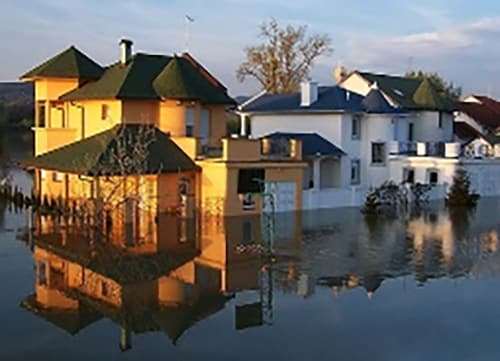
Find response and recovery activities for environmental health.
Find response activities by environmental health mission to help you fulfill your important roles in all-hazards emergency preparedness, response, recovery, and mitigation.
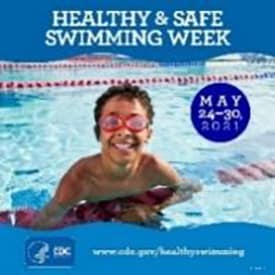
Promote healthy and safe swimming throughout the year.
Healthy and Safe Swimming Week is May 24–30, 2021, but healthy and safe swimming is important year-round. Find steps everyone can take to protect themselves and those they care about from injury and illness when swimming.

Celebrate 20 years of food safety research with the Environmental Health Specialists Network (EHS-Net).
Learn how EHS-Net uses data to improve food safety practice. Review highlights from 20 years of EHS-Net research, including key findings on restaurant actions linked with food safety and how EHS-Net research has strengthened food policies and practices.

June 7 is World Food Safety Day. The Food and Agriculture Organization and World Health Organization Food Safety Guide to World Food Safety Day 2021pdf icon describes how governments, organizations, food businesses, and the general public can take part.
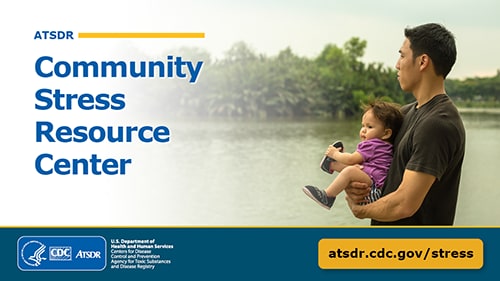
The Agency for Toxic Substances and Disease Registry’s (ATSDR’s) new Community Stress Resource Center outlines a framework for reducing community stress and building resilience as part of public health responses to environmental contamination. Communities have different practical, informational, social, and emotional needs and assets. The framework provides guidance and resources to understand, prevent, and address problems that can cause stress related to environmental contamination.
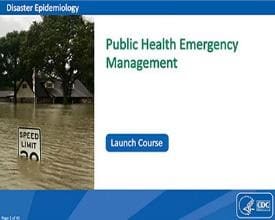
Disaster Epidemiology eLearning Training Modules
To aid in effective planning for disasters, NCEH has developed multiple eLearning courses that highlight the public health-related effects of disasters. We anticipate that once state, tribal, local, and territorial health departments and other partners have received the web-based training, they will have a better understanding of how to apply epidemiologic concepts to disasters and emergencies.
The course is made up of four modules:
• Public Health Impacts of Disasters
• Public Health Emergency Management
• Community Assessment for Public Health Emergency Response (CASPER)
• Disaster Surveillance.
Continuing Education (CE) is available for all modules
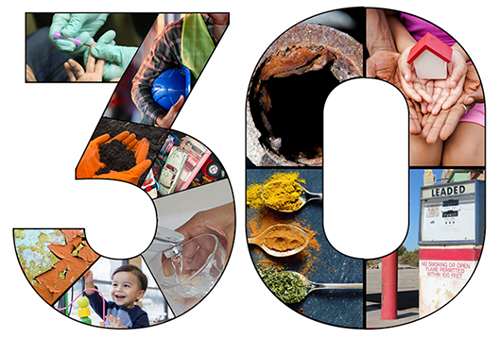
CDC’s Childhood Lead Poisoning Prevention Program (CLPPP) commemorates 30 years of funding state and local childhood lead poisoning prevention programs to eliminate childhood lead poisoning as a public health problem. To mark this milestone, we have launched a webpage and have planned a social media campaign to raise awareness that childhood lead poisoning persists.
Thank you for reading and for helping to keep our environments healthy.
If you are not yet a subscriber, please click here, enter your email address, and click the subscribe button at the bottom of the webpage.